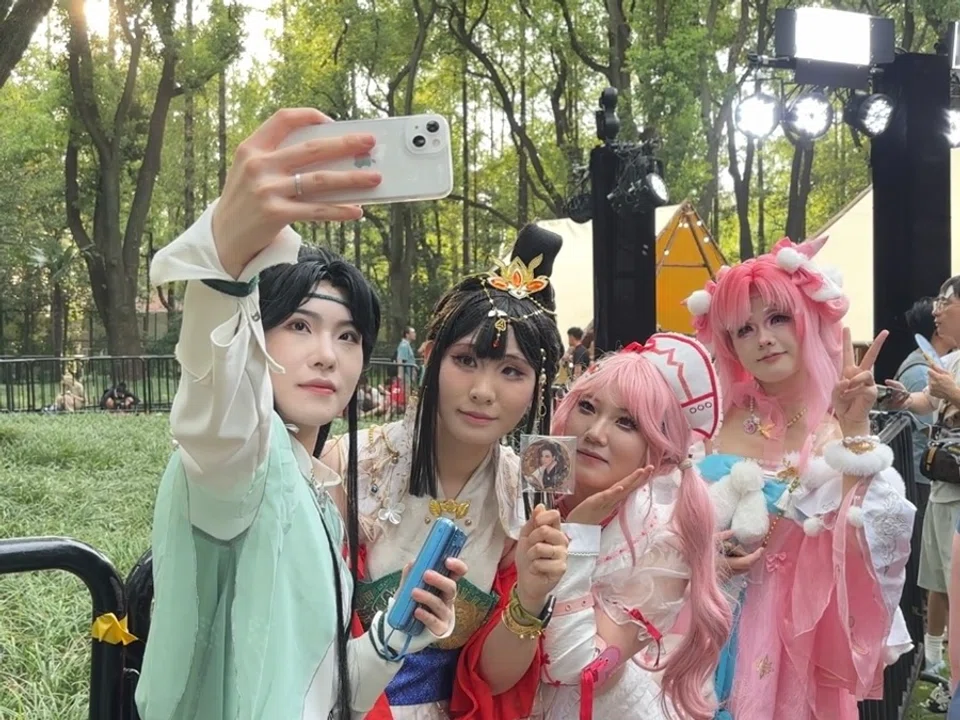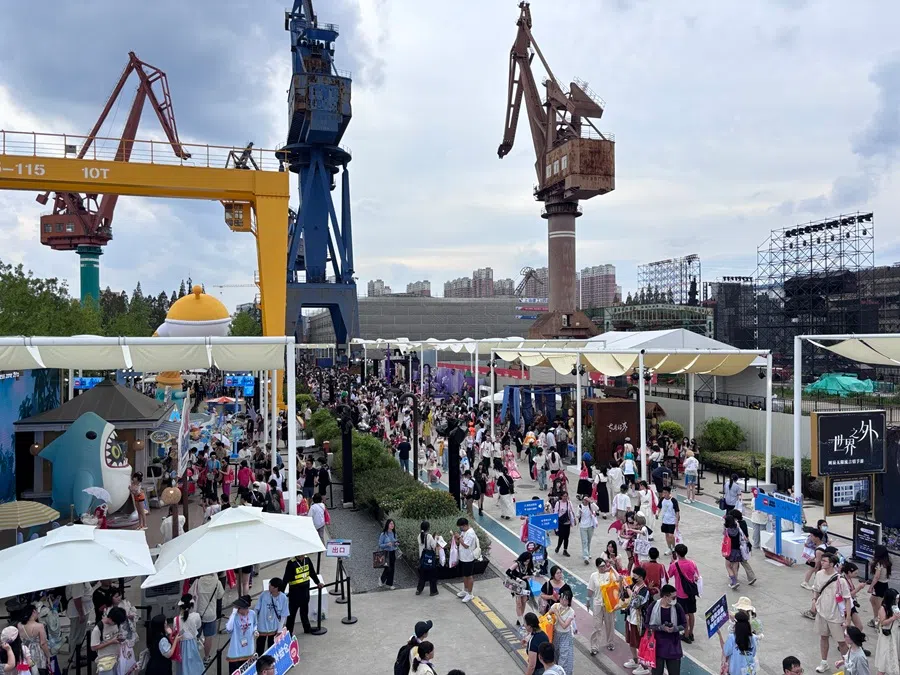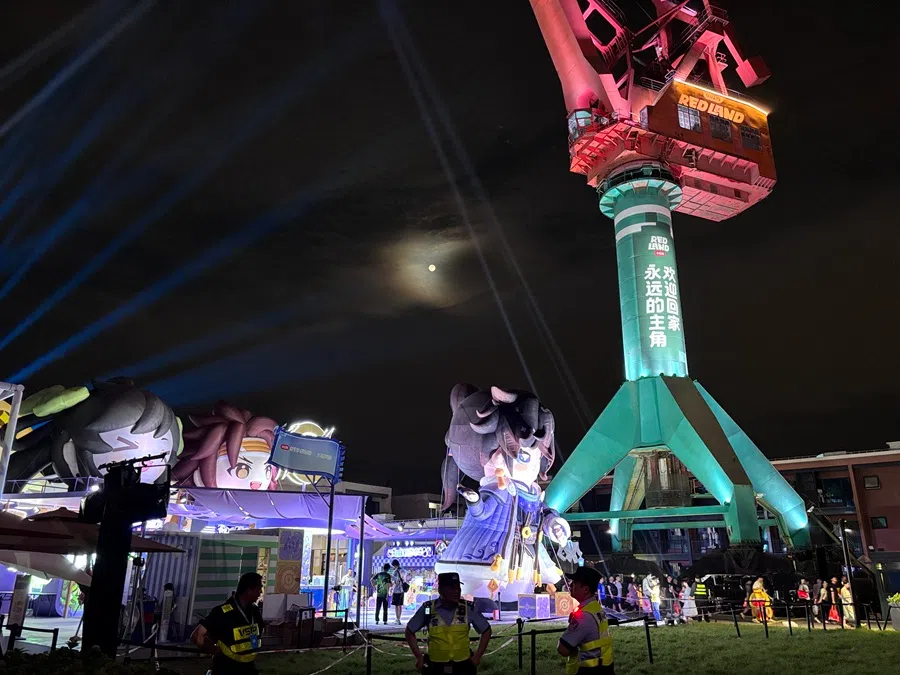[Video] Cosplay goes mainstream: China’s 2D subculture is now big business
The two-dimensional world is seeing a renaissance in China’s cultural landscape, especially as consumers shift from product consumption to emotional consumption. Lianhe Zaobao correspondent Li Kang steps into the cosplaying world to find out more.

“Welcome home, my shining star. You are finally here!” A fully dressed “forest elf” emerges to warmly greet you as you step onto Fuxing Island.
On 8 to 10 August, more than 100,000 “two-dimensional (2D) world” enthusiasts and cosplayers flooded onto the only inland island along the Huangpu river in Shanghai, immersing themselves in a “2.5D open world” where games, comics and anime come alive.
Prior to Red Land, an open-world adventure island event organised by Chinese social media platform Rednote, the annual comic convention (comic con) BilibiliWorld organised by Chinese video platform Bilibili, as well as the government-backed China International Cartoon & Game Expo (CCG Expo) and ChinaJoy, all took place in Shanghai since July, creating a month-long anime craze summer.
Next generation and iteration of cosplay culture
Third-year university student Liu Yu (pseudonym) came specially from Nanjing to Shanghai to become one of the “protagonists” landing on Fuxing Island on 9 August. Unlike traditional comic cons, on Fuxing Island, every player transforms into a game protagonist, unlocking storylines based on their assigned character roles and earning medals upon completing missions.
Most players on the island are post-2000s, with a portion being post-80s and post-90s 2D-world enthusiasts.
Liu told Lianhe Zaobao that his first comic con experience had changed his perceptions; he was especially impressed with the people dressed as non-player characters (NPCs), as if he had truly stepped into a game.
Most players on the island are post-2000s, with a portion being post-80s and post-90s 2D-world enthusiasts. Among them, the most eye-catching were the cosplayers with unique costumes. Within half an hour of arriving on the island, Yukisuke (stage name), roleplaying as virtual character Hatsune Mikuo, was surrounded by over 30 people looking to take pictures with him.
Yukisuke told Lianhe Zaobao that in recent years, the 2D-world culture in China has been increasingly understood and accepted, with cosplay events held in Shanghai nearly every week. “Many peripherals and IPs have broken out, and domestic anime have also gained more attention,” he noted.
The popularity of anime, manga and games is a reflection of the continuous growth of the 2D-world community in China. According to data provided by RedNote, looking at content posted on the platform over the past year, 2D-world related content and gaming content grew by 175% and 168% year-on-year respectively, becoming the two largest categories after fashion and food.
... the 2D-world industry in China is relatively open with regard to copyright, encouraging fan creations and derivative works, which in turn foster a healthy creative ecosystem.

Moreover, the current 2D-world community in China increasingly integrates games and anime into daily life, such as celebrating the birthdays of game characters in the real world, or wearing cosplay-themed attire at graduation ceremonies.
Sanbing, RedNote’s head of tech-focused initiatives, pointed out that the first 2D-world boom occurred ten years ago, and the current trend of moving towards offline 2.5D experiences is “a key epoch trend”, signalling a renaissance for the 2D-world.
... anime used to be a subculture in China’s cultural landscape, but with the rise of the post-90s and post-2000s generations that grew up watching anime and reading manga, it has gradually entered the mainstream cultural sphere of Chinese society. — Professor Xu Jian, School of Media and Communication, Shanghai Jiao Tong University
Sanbing noted that this trend involved both generational cultural differences and cultural iteration. The new generation of youths is characterised as “outgoing and connected” and were raised without negative perceptions of people’s interest in the 2D-world.
Additionally, the 2D-world industry in China is relatively open with regard to copyright, encouraging fan creations and derivative works, which in turn foster a healthy creative ecosystem.
Entering mainstream cultural sphere
Xu Jian, a professor at the School of Media and Communication at Shanghai Jiao Tong University, told Lianhe Zaobao that the Shanghai Summer International Animation Month organised by the authorities signifies a major era shift, as Shanghai moves towards becoming a “global youth trend city”.
Xu stated that anime used to be a subculture in China’s cultural landscape, but with the rise of the post-90s and post-2000s generations that grew up watching anime and reading manga, it has gradually entered the mainstream cultural sphere of Chinese society.
... the gaming and anime craze has also stimulated new consumer potential amid China’s efforts to boost domestic demand.

Over the past year, several Chinese IPs like Black Myth: Wukong and Ne Zha 2 have gained immense popularity, drawing international attention towards Chinese games and anime. Xu pointed out that from this angle, the flurry of comic cons has also become a cultural platform, allowing organisers to “give a voice to China” outside of the US and Japan, and is representative of China’s effort to gain global cultural discourse.
Meanwhile, the gaming and anime craze has also stimulated new consumer potential amid China’s efforts to boost domestic demand. Xu explained that the shift from product consumption to emotional consumption, such as in gaming and anime, represents a change in consumption patterns.
He noted that as a representative city of China’s consumption transformation, Shanghai is exploring emotional consumption after hitting the growth ceiling for product consumption patterns.
He surmised, “The inaugural International Animation Month is merely an addition to the array of past events. In three to five years, there will be much deeper integration, with more new scenarios and phenomena emerging, in turn attracting more market forces to join.”
This article was first published in Lianhe Zaobao as “从二次元到2.5次元 中国新世代亚文化渐入主流”.



![[Big read] China’s 10 trillion RMB debt clean-up falls short](https://cassette.sphdigital.com.sg/image/thinkchina/d08cfc72b13782693c25f2fcbf886fa7673723efca260881e7086211b082e66c)
![[Big read] Love is hard to find for millions of rural Chinese men](https://cassette.sphdigital.com.sg/image/thinkchina/16fb62fbcf055b710e38d7679f82264ad682ce8b45542008afeb14d369a94399)
